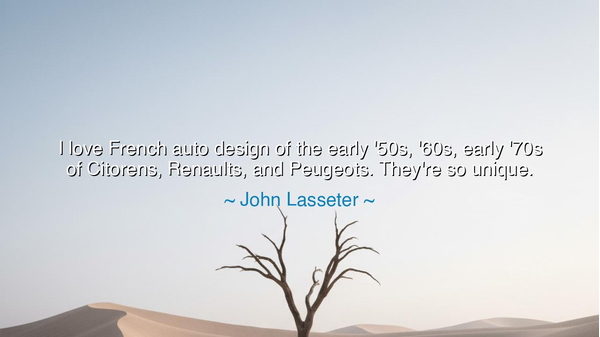
I love French auto design of the early '50s, '60s, early '70s of
I love French auto design of the early '50s, '60s, early '70s of Citorens, Renaults, and Peugeots. They're so unique.






In the affectionate and discerning words of John Lasseter, the phrase — “I love French auto design of the early '50s, '60s, early '70s — of Citroëns, Renaults, and Peugeots. They're so unique.” — is not merely a reflection on the beauty of machines, but a hymn to imagination, individuality, and the courage to be different. Beneath its simple expression lies the heart of a creator — one who sees beyond metal and glass to the soul of design itself. Lasseter, a storyteller and visionary, speaks here not as a collector of cars but as an admirer of the spirit of creation — that daring impulse which, in its truest form, seeks not to imitate, but to express.
The meaning of this quote lies in its celebration of uniqueness — of that quality which separates the merely functional from the truly inspired. The French automobiles of the mid-20th century — the elegant Citroëns, the spirited Renaults, the graceful Peugeots — were more than vehicles; they were statements of character. Their lines curved with emotion, their proportions defied convention, and their presence evoked both art and motion. To Lasseter, who built his own legacy in animation and design, these cars embodied the same principle that guides all timeless creativity: that to create with meaning, one must dare to be original, even if the world does not understand.
The origin of Lasseter’s sentiment comes from his lifelong devotion to art and storytelling. As the creative force behind Pixar, he understood that the heart of every great work lies in its authenticity. He admired French auto design precisely because it captured that authenticity — each model carrying the distinct fingerprint of its maker. In an era where many sought only efficiency, the French engineers of the 1950s and 1960s pursued beauty with purpose, designing cars that reflected poetry, culture, and optimism. Lasseter’s love for these designs reveals his kinship with their creators — for he, too, built worlds that balanced technical mastery with emotional truth.
Consider the story of the Citroën DS, unveiled in 1955 — a car so revolutionary that it seemed to descend from the future. Its smooth, aerodynamic form, self-leveling suspension, and fearless styling stunned the world. It was not simply designed; it was imagined. To drive it was to feel the harmony of art and engineering, grace and innovation. When it debuted at the Paris Motor Show, thousands placed orders within minutes, not out of practicality, but out of awe. The DS, like Lasseter’s animated worlds, taught humanity that technology could serve beauty, and that the pursuit of elegance need not bow to convention.
There is a deeper wisdom in Lasseter’s admiration for these cars. He reminds us that true uniqueness arises not from rebellion, but from sincerity. The French designers of that age were not trying to be different for its own sake; they were expressing a national and human identity — whimsical, romantic, daring, unafraid of imperfection. In the same way, Lasseter’s own films — from Toy Story to Cars — are imbued with the same philosophy: the belief that design, like storytelling, should speak from the heart. A work that imitates others may gain approval, but only the work that reveals the creator’s soul will endure through generations.
In these words, we also find a lesson in courage. The world often pressures creators to conform — to repeat what works, to follow what sells. But Lasseter reminds us that greatness comes from those who listen instead to the inner rhythm of their imagination. The French carmakers dared to craft designs that others found strange, even impractical — yet decades later, they are remembered not for their flaws, but for their boldness. So it is in all creative and noble endeavors: those who seek perfection may fade, but those who seek truth and originality carve their names into eternity.
Let this, then, be the teaching passed on to all who create or aspire: cherish your uniqueness. Whether you craft machines, stories, art, or dreams, do not be afraid to stand apart. Let your work bear your signature, your heart, your unmistakable humanity. Utility may fill the present, but originality fills the future. Design not for applause, but for meaning. Seek to create things that are “so unique” that they remind the world of what it means to feel, to marvel, to live.
And so, my listener, remember the wisdom of John Lasseter: “I love French auto design... they’re so unique.” For in those words lies a timeless truth — that beauty, at its highest form, is not found in perfection or conformity, but in the courage to be different. Let your life, like those cars of the golden age, move not just across roads, but through hearts — elegant, daring, and wholly your own.






AAdministratorAdministrator
Welcome, honored guests. Please leave a comment, we will respond soon